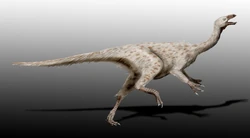| Ornithomimosaurs Fossil range: Early - Late Cretaceous | |
|---|---|
 | |
| Scientific classification
| |
|
Class |
|
|
Superorder |
|
|
Order |
|
|
Suborder |
|
|
(Unranked) |
Ornithomimiformes |
|
Superfamily |
|
| |
The Ornithomimosauria, ornithomimosaurs ("bird-mimic lizards") or ostrich dinosaurs[1] were theropod dinosaurs which bore a superficial resemblance to modern ostriches. They were fast, omnivorous or herbivorous dinosaurs from the Cretaceous Period of Laurasia (now Asia, Europe and North America). The group first appeared in the Early Cretaceous and persisted until the Late Cretaceous. They appear to be related to less-derived coelurosaurian theropods such as Compsognathus and tyrannosaurids. Primitive members of the group include Pelecanimimus, Shenzhousaurus, Harpymimus and probably the huge Deinocheirus, the arms of which reached 2.4 m (8 feet) in length. More advanced species, members of the family Ornithomimidae, include Gallimimus, Archaeornithomimus, Anserimimus, Struthiomimus, and Ornithomimus. Some paleontologists, like Paul Sereno, consider the enigmatic alvarezsaurids to be close relatives of the ornithomimosaurs and place them together in the superfamily Ornithomimoidea (see classification below).
Description[]
The skulls of ornithomimosaurs were small, with large eyes, above relatively long and slender necks. Some primitive species (such as Pelecanimimus and Harpymimus) had teeth, but most had toothless beaks.

Struthiomimus forelimb, showing claws (from OUMNH).
The fore limbs ('arms') were long and slender and bore powerful claws. The hind limbs were long and powerful, with a long foot and short, strong toes terminating in hooflike claws. Ornithomimosaurs were probably among the fastest of all dinosaurs. Like many other coelurosaurs, the ornithomimosaurian hide was probably feathered rather than scaly.
Diet[]
Ornithomimosaurs probably acquired most of their calories from plants. Many ornithomimosaurs, including primitive species, have been found with numerous gastroliths in their stomachs, characteristic of herbivores. Henry Fairfield Osborn suggested that the long, sloth-like 'arms' of ornithomimosaurs may have been used to pull down branches on which to feed, an idea supported by further study of their strange, hook-like hands.[2] The sheer abundance of ornithomimids — they are the most common small dinosaurs in North America — is consistent with the idea that they were plant eaters, as herbivores usually outnumber carnivores in an ecosystem. However, they may have been omnivores that ate both plants and small animal prey.
Thanks to well-preserved specimens of Ornithomimus, some of the anatomy of the inside of ornithomimid beaks has been observed. A 2001 study showed that the inside walls of the beak possessed vertical ridges, similar to those found in modern ducks. This led some paleontologists to suggest ornithomimids may have been filter feeders, which strained water through their beaks to consume small aquatic organisms.[3] However, others have argued against this interpretation, pointing out that similar structures are found in the beaks of a wide variety of non-filter feeding beaked animals, including turtles, and have no relation to filter feeding.[4]
Systematics[]
Named by Marsh in 1890, the family Ornithomimidae was originally classified as a group of "megalosaurs" (a "wastebasket taxon" containing any medium to large sized theropod dinosaurs), but as more theropod diversity was uncovered, their true relationships to other theropods started to resolve, and they were moved to the Coelurosauria. Recognizing the distinctivness of ornithomimids compared to other dinosaurs, Rinchen Barsbold placed ornithomimids within their own infraorder, Ornithomimosauria, in 1976. The contents of Ornithomimidae and Ornithomimosauria varied from author to author as cladistic definitions began to appear for the groups in the 1990s. Paul Sereno, for example, used Ornithomimidae to include all of Ornithomimosauria in 1998, and subsequently switched to a more exclusive definition that nested Ornithomimidae (advanced ornthimomimes) within the larger stem-group Ornithomimosauria, a classification scheme that is mirrored by most other literature in the early 2000s.
Taxonomy[]

- Infraorder Ornithomimosauria
- Pelecanimimus (central Spain)
- Shenzhousaurus (northeastern China)
- Family Deinocheiridae
- Family Garudimimidae
- Garudimimus (Mongolia)
- Family Harpymimidae
- Harpymimus (Mongolia)
- Beishanlong (northeastern China)
- Family Ornithomimidae
- Anserimimus (Mongolia)
- Archaeornithomimus (China)
- Dromiceiomimus (Alberta)
- Gallimimus (Mongolia)
- Ornithomimus (Colorado and Alberta)
- Sinornithomimus (Inner Mongolia)
- Struthiomimus (Montana and Alberta)
Note that, Timimus, early Cretaceous fossil remains (a femur) from Dinosaur Cove in Victoria in southeastern Australia are possibly ornithomimosaurian.
Phylogeny[]
Ornithomimosauria has variously been used for the branch-based group of all dinosaurs closer to Ornithomimus than to birds, and in more restrictive senses. The more exclusive sense began to grow in popularity when the possibility arose that alvarezsaurids might fall under Ornithomimosauria if an inclusive definition were adopted. Another clade, Ornithomimiformes, was defined by Sereno (2005) as (Ornithomimus velox > Passer domesticus) and replaces the more inclusive use of Ornithomimosauria when alvarezsaurids or some other group are found to be closer relatives of ornithomimosaurs than maniraptorans, with Ornithomimosauria redefined to include dinosaurs closer to Ornithomimus than to alvarezsaurids.
The cladogram presented here follows the one recovered by Turner, Clarke, Ericson and Norell, 2007.[5] Clade names follow definitions provided by Sereno, 2005.[6]
| Ornithomimosauria |
| ||||||||||||||||||||||||||||||||||||||||||
References[]
- ^ British Museum (Natural History) page on ostrich dinosaurs.
- ^ Nicholls, E. L., and Russell, A. P. (1985). "Structure and function of the pectoral girdle and forelimb of Struthiomimus altus (Theropoda: Ornithomimidae)." Palaeontology, 28: 643-677.
- ^ Norell, M. A., Makovicky, P., and Currie, P. J. (2001). "The beaks of ostrich dinosaurs." Nature, 412: 873-874.
- ^ Barrett, P. M. (2005). "The diet of ostrich dinosaurs (Theropoda: Ornithomimosauria)." Palaeontology, 48: 347-358.
- ^ Turner, A.H., Pol, D., Clarke, J.A., Erickson, G.M., and Norell, M. (2007). "Supporting online material for: A basal dromaeosaurid and size evolution preceding avian flight". Science, 317: 1378-1381. doi:10.1126/science.1144066 (supplement)
- ^ Sereno, P. C. 2005. Stem Archosauria—TaxonSearch [version 1.0, 2005 November 7]
External links[]
- Khalaf-von Jaffa, Norman Ali Bassam Ali Taher (2006). Ornithomimid Dinosaur Tracks from Beit Zeit, West of Jerusalem, Palestine.Gazelle: The Palestinian Biological Bulletin. Number 56, August 2006. pp. 1-7.